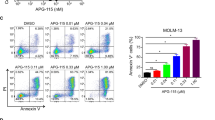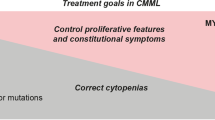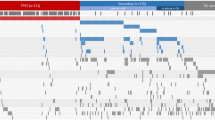Abstract
Acute myeloid leukemia (AML) is driven by leukemia stem cells (LSCs) that resist conventional chemotherapy and are the major cause of relapse1,2. Hypomethylating agents (HMAs) are the standard of care in the treatment of older or unfit patients with AML, but responses are modest and not durable3,4,5. Here we demonstrate that LSCs upregulate the tumor necrosis factor family ligand CD70 in response to HMA treatment resulting in increased CD70/CD27 signaling. Blocking CD70/CD27 signaling and targeting CD70-expressing LSCs with cusatuzumab, a human αCD70 monoclonal antibody with enhanced antibody-dependent cellular cytotoxicity activity, eliminated LSCs in vitro and in xenotransplantation experiments. Based on these preclinical results, we performed a phase 1/2 trial in previously untreated older patients with AML with a single dose of cusatuzumab monotherapy followed by a combination therapy with the HMA azacitidine (NCT03030612). We report results from the phase 1 dose escalation part of the clinical trial. Hematological responses in the 12 patients enrolled included 8 complete remission, 2 complete remission with incomplete blood count recovery and 2 partial remission with 4 patients achieving minimal residual disease negativity by flow cytometry at <10−3. Median time to response was 3.3 months. Median progression-free survival was not reached yet at the time of the data cutoff. No dose-limiting toxicities were reported and the maximum tolerated dose of cusatuzumab was not reached. Importantly, cusatuzumab treatment substantially reduced LSCs and triggered gene signatures related to myeloid differentiation and apoptosis.
This is a preview of subscription content, access via your institution
Access options
Access Nature and 54 other Nature Portfolio journals
Get Nature+, our best-value online-access subscription
$29.99 / 30 days
cancel any time
Subscribe to this journal
Receive 12 print issues and online access
$209.00 per year
only $17.42 per issue
Buy this article
- Purchase on Springer Link
- Instant access to full article PDF
Prices may be subject to local taxes which are calculated during checkout




Similar content being viewed by others
Data availability
The patient-related clinical datasets in the paper were generated during and analyzed as part of a multicenter clinical trial (NCT03030612). The datasets are not publicly available because the trial is ongoing, but data can be requested by any qualified researcher after data lock and trial completion or upon reasonable request. All RNA raw data and analyzed sequencing data can be retrieved from the Gene Expression Omnibus and are available under accession no. GSE147989 (scRNA-seq). All other data that support the findings of the study are available from the corresponding authors upon request.
Code availability
The code used for the analysis of the single-cell sequencing data is available from the corresponding author upon request.
References
Lapidot, T. et al. A cell initiating human acute myeloid leukaemia after transplantation into SCID mice. Nature 367, 645–648 (1994).
Thomas, D. & Majeti, R. Biology and relevance of human acute myeloid leukemia stem cells. Blood 129, 1577–1585 (2017).
Dombret, H. et al. International phase 3 study of azacitidine vs conventional care regimens in older patients with newly diagnosed AML with >30% blasts. Blood 126, 291–299 (2015).
Kantarjian, H. M. et al. Multicenter, randomized, open-label, phase III trial of decitabine versus patient choice, with physician advice, of either supportive care or low-dose cytarabine for the treatment of older patients with newly diagnosed acute myeloid leukemia. J. Clin. Oncol. 30, 2670–2677 (2012).
Craddock, C. et al. Azacitidine fails to eradicate leukemic stem/progenitor cell populations in patients with acute myeloid leukemia and myelodysplasia. Leukemia 27, 1028–1036 (2013).
Bowman, M. R. et al. The cloning of CD70 and its identification as the ligand for CD27. J. Immunol. 152, 1756–1761 (1994).
Nolte, M. A., van Olffen, R. W., van Gisbergen, K. P. J. M. & van Lier, R. A. W. Timing and tuning of CD27–CD70 interactions: the impact of signal strength in setting the balance between adaptive responses and immunopathology. Immunol. Rev. 229, 216–231 (2009).
Liu, N., Sheng, X., Liu, Y., Zhang, X. & Yu, J. Increased CD70 expression is associated with clinical resistance to cisplatin-based chemotherapy and poor survival in advanced ovarian carcinomas. Onco Targets Ther. 6, 615–619 (2013).
Ge, H. et al. Tumor associated CD70 expression is involved in promoting tumor migration and macrophage infiltration in GBM. Int. J. Cancer 141, 1434–1444 (2017).
Bertrand, P. et al. The costimulatory molecule CD70 is regulated by distinct molecular mechanisms and is associated with overall survival in diffuse large B-cell lymphoma. Genes Chromosome. Canc. 52, 764–774 (2013).
Riether, C. et al. CD70/CD27 signaling promotes blast stemness and is a viable therapeutic target in acute myeloid leukemia. J. Exp. Med. 214, 359–380 (2017).
Lu, Q., Wu, A. & Richardson, B. C. Demethylation of the same promoter sequence increases CD70 expression in lupus T cells and T cells treated with lupus-inducing drugs. J. Immunol. 174, 6212–6219 (2005).
Cashen, A. F., Schiller, G. J., O’Donnell, M. R. & DiPersio, J. F. Multicenter, phase II study of decitabine for the first-line treatment of older patients with acute myeloid leukemia. J. Clin. Oncol. 28, 556–561 (2010).
Marcucci, G., Silverman, L., Eller, M., Lintz, L. & Beach, C. L. Bioavailability of azacitidine subcutaneous versus intravenous in patients with the myelodysplastic syndromes. J. Clin. Pharmacol. 45, 597–602 (2005).
Döhner, H. et al. Diagnosis and management of AML in adults: 2017 ELN recommendations from an international expert panel. Blood 129, 424–447 (2017).
Liu, S. et al. Sp1/NFκB/HDAC/miR-29b regulatory network in KIT-driven myeloid leukemia. Cancer Cell 17, 333–347 (2010).
Garzon, R. et al. MicroRNA-29b induces global DNA hypomethylation and tumor suppressor gene reexpression in acute myeloid leukemia by targeting directly DNMT3A and 3B and indirectly DNMT1. Blood 113, 6411–6418 (2009).
Armour, K. L., Clark, M. R., Hadley, A. G. & Williamson, L. M. Recombinant human IgG molecules lacking Fcγ receptor I binding and monocyte triggering activities. Eur. J. Immunol. 29, 2613–2624 (1999).
Silence, K. et al. ARGX-110, a highly potent antibody targeting CD70, eliminates tumors via both enhanced ADCC and immune checkpoint blockade. MAbs 6, 523–532 (2014).
Kersten, B. et al. CD45RA, a specific marker for leukaemia stem cell sub-populations in acute myeloid leukaemia. Br. J. Haematol. 173, 219–235 (2016).
Hu, Y. & Smyth, G. K. ELDA: extreme limiting dilution analysis for comparing depleted and enriched populations in stem cell and other assays. J. Immunol. Methods 347, 70–78 (2009).
Chou, T.-C. Drug combination studies and their synergy quantification using the Chou–Talalay method. Cancer Res. 70, 440–446 (2010).
Perna, F. et al. Integrating proteomics and transcriptomics for systematic combinatorial chimeric antigen receptor therapy of AML. Cancer Cell 32, 506–519.e5 (2017).
Shinkawa, T. et al. The absence of fucose but not the presence of galactose or bisecting N-acetylglucosamine of human IgG1 Complex-type oligosaccharides shows the critical role of enhancing antibody-dependent cellular cytotoxicity. J. Biol. Chem. 278, 3466–3473 (2003).
Perl, A. E. The role of targeted therapy in the management of patients with AML. Hematology Am. Soc. Hematol. Educ. Progr. 2017, 54–65 (2017).
Pollyea, D. A. et al. Venetoclax with azacitidine disrupts energy metabolism and targets leukemia stem cells in patients with acute myeloid leukemia. Nat. Med. 24, 1859–1866 (2018).
Veselý, J. & Cihák, A. Incorporation of a potent antileukemic agent, 5-aza-2′-deoxycytidine, into DNA of cells from leukemic mice. Cancer Res. 37, 3684–3689 (1977).
Paczulla, A. M. et al. Long-term observation reveals high-frequency engraftment of human acute myeloid leukemia in immunodeficient mice. Haematologica 102, 854–864 (2017).
Harris, P. A. et al. Research electronic data capture (REDCap)—a metadata-driven methodology and workflow process for providing translational research informatics support. J. Biomed. Inform. 42, 377–381 (2009).
Murone, M. et al. The multi-kinase inhibitor Debio 0617B reduces maintenance and self-renewal of primary human AML CD34+ stem/progenitor cells. Mol. Cancer Ther. 16, 1497–1510 (2017).
Wang, J. C. Y. & Dick, J. E. Cancer stem cells: lessons from leukemia. Trends Cell Biol. 15, 494–501 (2005).
Majeti, R. et al. CD47 Is an adverse prognostic factor and therapeutic antibody target on human acute myeloid leukemia stem cells. Cell 138, 286–299 (2009).
Carr, I. M. et al. Inferring relative proportions of DNA variants from sequencing electropherograms. Bioinformatics 25, 3244–3250 (2009).
Dobin, A. et al. STAR: ultrafast universal RNA-seq aligner. Bioinformatics 29, 15–21 (2013).
Butler, A., Hoffman, P., Smibert, P., Papalexi, E. & Satija, R. Integrating single-cell transcriptomic data across different conditions, technologies, and species. Nat. Biotechnol. 36, 411–420 (2018).
Ilicic, T. et al. Classification of low quality cells from single-cell RNA-seq data. Genome Biol. 17, 29 (2016).
Cheson, B. D. et al. Revised recommendations of the international working group for diagnosis, standardization of response criteria, treatment outcomes, and reporting standards for therapeutic trials in acute myeloid leukemia. J. Clin. Oncol. 21, 4642–4649 (2003).
Schuurhuis, G. J. et al. Minimal/measurable residual disease in AML: a consensus document from the European LeukemiaNet MRD working party. Blood 131, 1275–1291 (2018).
Acknowledgements
We thank U. Lüthi and T. Chiorazzo for providing excellent technical assistance; the FACSlab of the Department for BioMedical Research for assistance with cell sorting; the Next Generation Sequencing Platform of the University of Bern for performing the high-throughput sequencing experiments; and the Interfaculty Bioinformatics Unit of the University of Bern for providing the high-performance computing infrastructure. We especially thank the teams of the Clinical Research Unit of the Department of Medical Oncology, Bern University Hospital and University Hospital Zürich, the University of Zürich and the histopathology laboratory at the Institute of Pathology, Bern. In addition, we thank B. Lambrecht from Ghent University for helpful discussions during the preparation of the manuscript. The preclinical work was supported by grants from the Swiss National Science Foundation (nos. 31003A_149768 and 310030B_13313 to A.F.O., and 310030_179394 to C.R.), the Swiss Cancer League (no. KLS-3346-02-2014), the Sassella Foundation, the Fondazione Dr. Carlo Gianella, the Wolfermann-Nägeli Foundation, the Olga Mayenfisch Foundation, Alfred und Anneliese Sutter-Stöttner Foundation and the Fondazione per la Ricerca sulla Trasfusione e sui Trapianti (to C.R.). The clinical study was financed by argenx. The translational work was supported by the SAKK/Gateway/Rising Tide Foundation (to A.F.O).
Author information
Authors and Affiliations
Contributions
C.R. and A.F.O. conceived and designed the preclinical and translational experiments. A.F.O., T.P., U.B., S.F., N.L., E.E., D.G., L.V.R. and H.D.H. conceived and designed the clinical trial. A.F.O., T.P., R.M. and M.G.M. selected and treated the patients. C.R., T.P., S.H., U.B., Y.B., M.H., R.M., L.V.R., A.H., M.M., T.D., D.G., E.E., W.H.G., D.F., R.B. and N.L. collected and assembled the data. C.R., T.P., S.H., U.B., Y.B., M.H., A.F.O., W.H.G., D.F., R.B., L.V.R., A.H., M.M., T.D., D.G., E.E., H.D.H. and N.L. analyzed and interpreted the data. C.R., T.P., U.B., A.F.O., A.H., H.D.H. and N.L. wrote the manuscripts. All authors revised the manuscript and approved its final version.
Corresponding authors
Ethics declarations
Competing interests
C.R. and A.F.O. are listed as investors on a patent held by the University of Bern on targeting CD70 for the treatment of AML. M.M., T.D., N.L., E.E., D.G., L.V.R., A.H. and H.D.H are employees of argenx. S.F. is a consultant for argenx. All other authors declare no competing interests related to the current study.
Additional information
Peer review information Javier Carmona was the primary editor on this article and managed its editorial process and peer review in collaboration with the rest of the editorial team.
Publisher’s note Springer Nature remains neutral with regard to jurisdictional claims in published maps and institutional affiliations.
Supplementary information
Supplementary Information
Supplementary Tables 1–10 and Figs. 1–7.
Rights and permissions
About this article
Cite this article
Riether, C., Pabst, T., Höpner, S. et al. Targeting CD70 with cusatuzumab eliminates acute myeloid leukemia stem cells in patients treated with hypomethylating agents. Nat Med 26, 1459–1467 (2020). https://doi.org/10.1038/s41591-020-0910-8
Received:
Accepted:
Published:
Issue Date:
DOI: https://doi.org/10.1038/s41591-020-0910-8
This article is cited by
-
Transcriptional regulation of cancer stem cell: regulatory factors elucidation and cancer treatment strategies
Journal of Experimental & Clinical Cancer Research (2024)
-
The development of chimeric antigen receptor T-cells against CD70 for renal cell carcinoma treatment
Journal of Translational Medicine (2024)
-
TMIGD2 is an orchestrator and therapeutic target on human acute myeloid leukemia stem cells
Nature Communications (2024)
-
Recent progress in chimeric antigen receptor therapy for acute myeloid leukemia
Annals of Hematology (2024)
-
ImmunoPET/CT imaging of clear cell renal cell carcinoma with [18F]RCCB6: a first-in-human study
European Journal of Nuclear Medicine and Molecular Imaging (2024)



